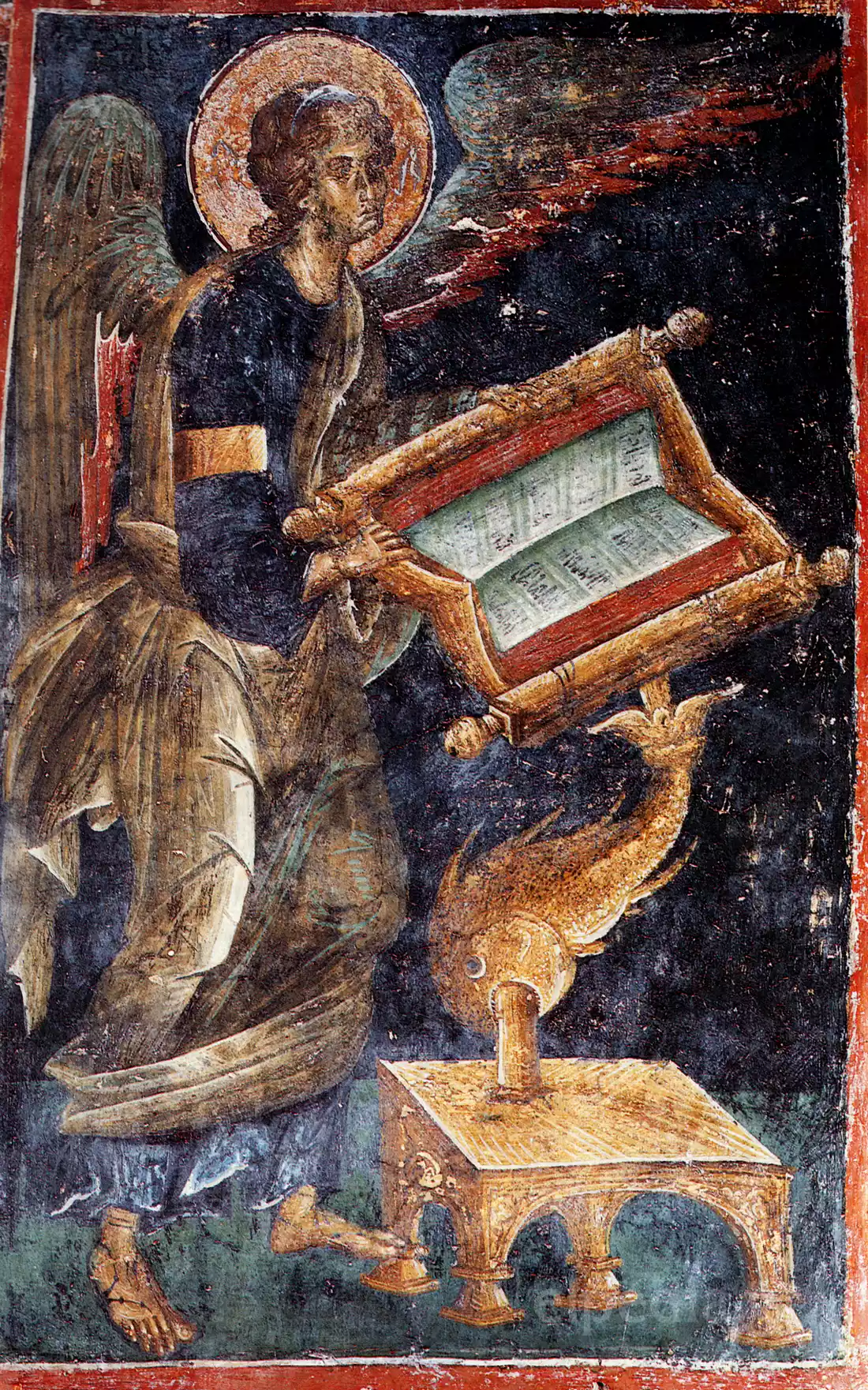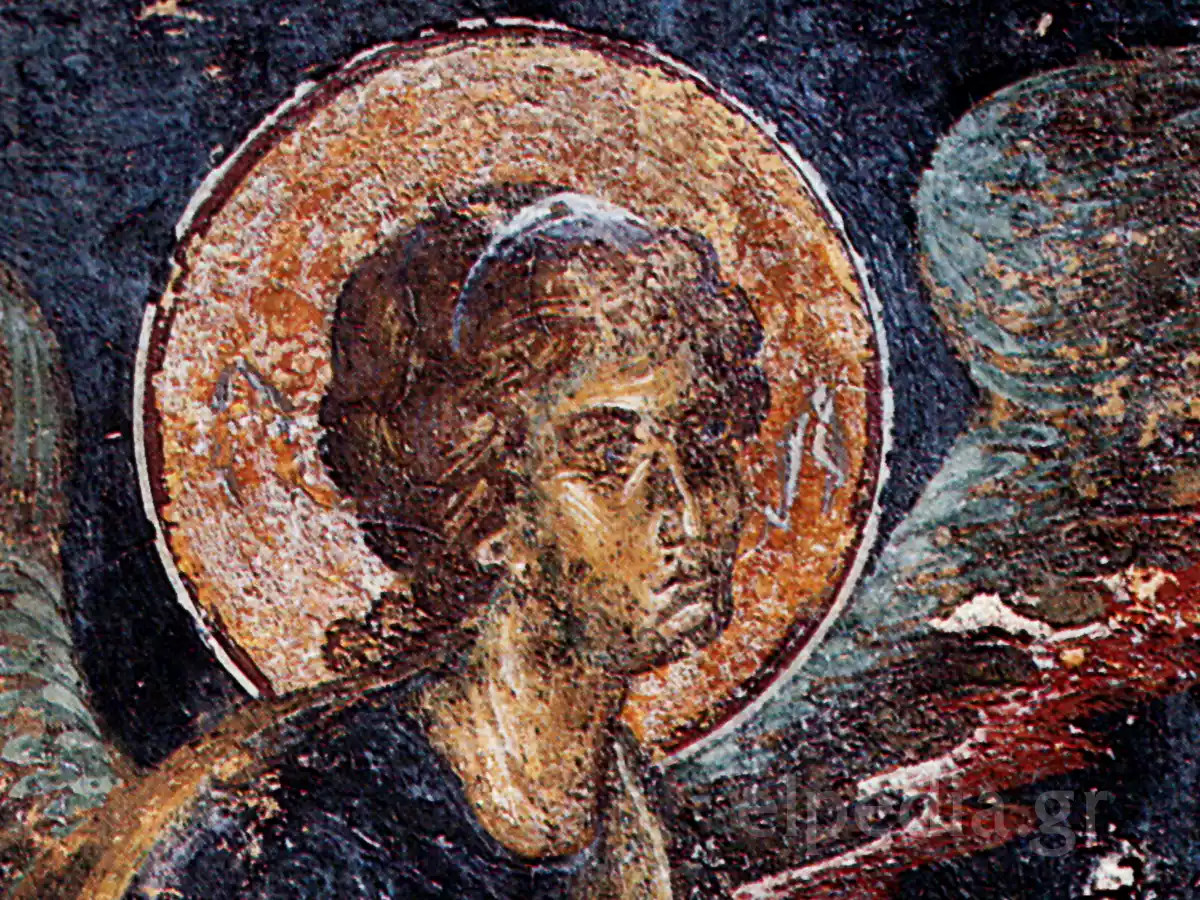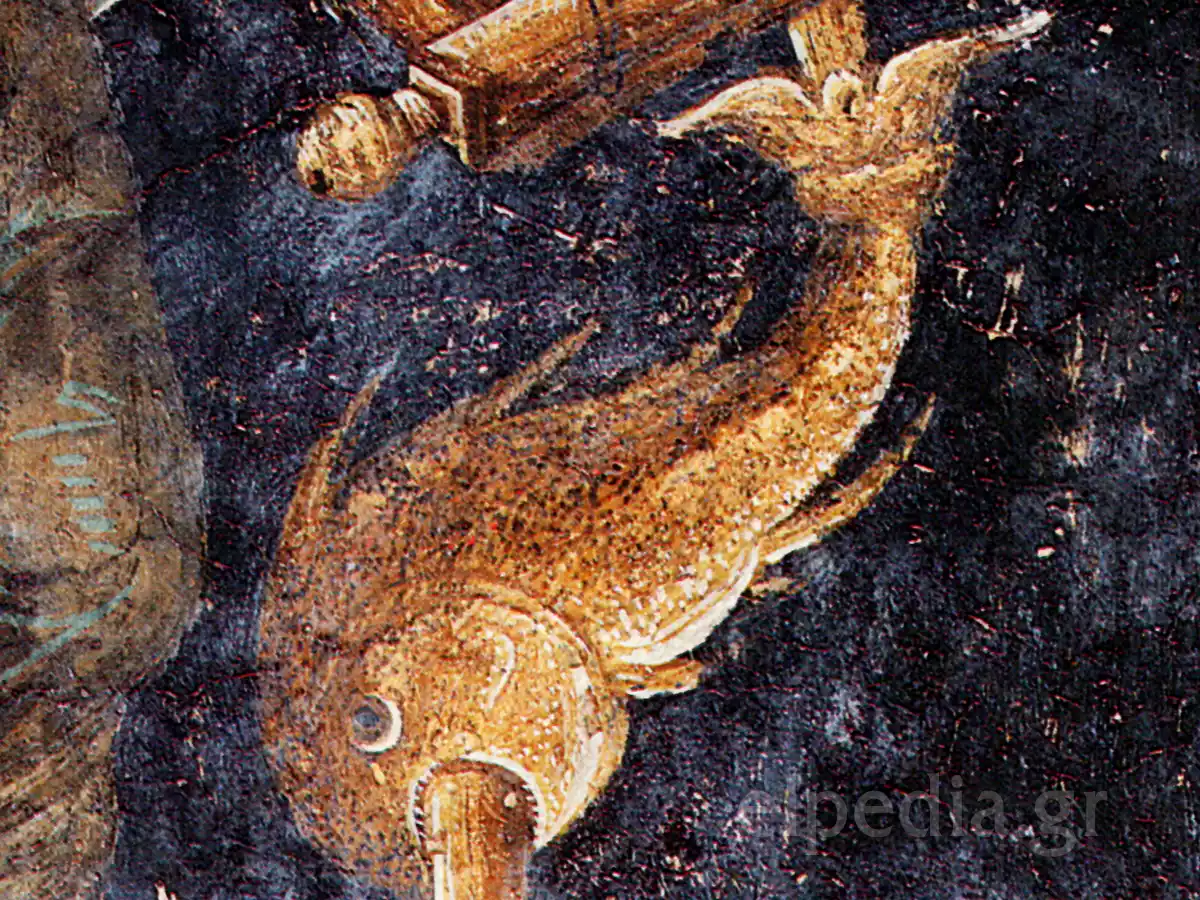
The Angel of the Second Coming, a rare Byzantine fresco (1291/92-1315) that adorns the narthex of the Metropolis of Mystras.
Title: Angel of the Second Coming
Artist: Unknown
Type: Fresco
Date: 1291/92-1315
Materials: Fresco
Location: Narthex of the Metropolis, Mystras, Greece
In the heart of the fortress city of Mystras, in the narthex of the Metropolis of Saint Demetrius, stands a silent witness of a past glory and deep faith: an angel. This is not an ordinary angel, but a figure inextricably linked to the eschatology of the Christian faith: the Angel of the Second Coming. This exceptional fresco, created between 1291/92 and 1315, is part of a larger and grand composition of the Second Coming that covers the vaulted ceiling and the walls of the narthex. The scene, featuring the Just Judge, the Preparation of the Throne, the resurrection of the dead, and the representations of Hell and Paradise, was intended to prepare the faithful for the final judgment. Within this imposing ensemble, the specific angel, depicted on the right jamb of the entrance, stands out. He is in a posture of alertness, reading from a large, open book placed on an elegant lectern. This figure, the heavenly reader, is relatively rare in the iconography of the Second Coming, making this particular fresco in the Metropolis of Mystras (Orthodox Church of Greece et al.) an object of study and admiration. The delicacy of the figure, the gracefulness, and the rhythm imparted by the raised wing compose a masterpiece of Byzantine art, inviting us to discover its deeper meanings.

The face of the Angel of Judgment with the golden halo. Notice the expressiveness and delicacy of the Byzantine technique in the Metropolis of Mystras.
The Fresco of the Angel of Judgment in the Metropolis of Mystras
Crossing the threshold of the Metropolis of Saint Demetrius in Mystras, the visitor enters a space where art and faith have coexisted for centuries. Here, in the narthex, unfolds one of the most impressive depictions of the Second Coming in Byzantine art, with the Angel we are examining playing a central role.
The Placement of the Fresco in the Narthex
The figure of the Angel of the Second Coming is not located randomly. It adorns the right jamb (the column that frames the door) of the western entrance of the narthex. Directly opposite, on the left jamb, another angel is depicted, also with an open book, although less well-preserved. Their placement on either side of the entrance is symbolic, as they function as heavenly guardians welcoming (or warning) the faithful about the impending judgment as they enter the main church. The figure stands beneath the depiction of the Preparation of the Throne, which dominates the western side of the narthex’s arch.
The Broader Depiction of the Second Coming
The Angel is an integral part of a much larger and multifaceted composition. The entire vaulted ceiling and the walls of the narthex are covered with scenes of the Second Coming (Ryan). The central figure is Christ as the Just Judge, surrounded by angels and apostles. Around him are depicted the Resurrection of the dead, with the earth and the sea giving up their dead, the horrific torments of the damned contrasted with the peace of Paradise, and of course, the Preparation of the Throne. The entire scene serves as a visual reminder and exhortation to the faithful to live righteously, reflecting on the final judgment. (Search for more information with the words: Iconography of the Second Coming Byzantine).
Historical Testimonies: The Founder’s Inscription
The historical starting point for the frescoes of the narthex is provided by a valuable marble inscription. Carved on the southern exterior side of the narthex, to the west, the inscription mentions as the founder the then Metropolitan of Laconia, Nikephoros Moschopoulos, and is dated to the year 1291/92. The inscription concludes with a wish and exhortation to the passing faithful, calling them to wish to stand on the right side of the Judge, along with the “sheep,” on the Day of Judgment, directly linking the act of founding with the eschatological content of the frescoes.
The Dating of the Work and Metropolitan Nikephoros
Nikephoros Moschopoulos served as Metropolitan of Laconia from 1288 until around 1315. The founder’s inscription of 1291/92 sets a clear terminus post quem (that is, the earliest possible limit) for the creation of the frescoes of the narthex. Scholars agree that the frescoes should not be temporally far removed from the carving of the inscription, likely completed shortly thereafter or during Moschopoulos’s episcopate, that is, by 1315. This period coincides with the beginning of the great flourishing of Mystras.
The Unique Iconography of the Reader Angel
What makes the angels on the jambs of the Metropolis particularly interesting is their specific role: they read the books of life (Rev. 20:12), where the deeds of men are recorded, in view of the judgment. This depiction of two reader angels on either side of the entrance, as part of the Second Coming, is considered quite rare. Similar themes can be found in the chapel of the Chora Monastery in Constantinople, but there the two angels with the books stand next to the Judge and wear royal garments. In Mystras, the angel functions as a pre-angel of Christ’s judgment (Cramer), a heavenly scribe revealing the deeds, emphasizing individual responsibility before God.

Artistic Analysis and Symbolism of the Fresco
Beyond its historical and theological significance, the fresco of the Angel of the Second Coming in the Metropolis of Mystras is an exceptional example of Byzantine art of the time. Its artistic perfection, technique, and symbolism make it a work worthy of careful analysis.
The Technique of the Fresco and the Palaiologan Art
The work is executed using the technique of fresco, where colors are applied to wet plaster, allowing the pigment to penetrate deeply and become one with the wall. This technique ensures great durability over time, as evidenced by the good state of preservation of the right angel. Artistically, it belongs to the broader movement of the Palaiologan Renaissance, a period of great artistic flourishing in Byzantium, despite political decline. The Byzantine frescoes of this period, and especially in Mystras, are characterized by a new sense of volume, movement, and expression (Christian Archaeological Society).
Visual Analysis: Colors, Design, and Light
Observing the image closely, you can almost feel the texture of the plaster beneath the color. The color palette, although influenced by the passage of time, retains an elegance. Earthy tones, browns, ochres, and the dark blue of the background dominate, creating an atmosphere of seriousness and mystery. The gold color, used in the halo, the ornate lectern, and the details of the book, adds brilliance and emphasizes the sacredness of the scene. The design is dynamic yet elegant. The brushstrokes, if we could see them up close, would reveal the skill of the unknown artist in rendering the drapery of the garment and the wings. The way the light falls (as we imagine it in the original space of the narthex, perhaps from a window or from candles) would dramatically highlight the volume of the figure and the shiny surfaces of the gold.
The Form of the Angel: Posture, Movement, and Expression
The angel is depicted in a posture full of vitality and alertness. It is not a static, expressionless figure. His body is slender, with a slight tilt, as if he has just stopped to read or is preparing to continue his heavenly mission. His right wing, large and raised, is dynamically outlined against the dark background, imparting a strong rhythm and a sense of upward and rightward movement. This element, combined with the gracefulness of the figure and the careful rendering of the facial features, creates a sense of heavenly grace. His gaze, although somewhat worn, appears serious and focused on his task.
The Symbolism of the Book and the Lectern
The central element of the scene is the large, open book held by the angel. It symbolizes the “Book of Life” or the books where the deeds of men are recorded, according to the Revelation of John. Its reading by the angel at the time of Judgment signifies the revelation of all before God and the impartial judgment based on each person’s works. The lectern itself, on which the book rests, is unusually ornate and valuable, likely to emphasize the importance of the book’s content. It is gilded, with an elegant design, adding formality to the scene. (Search for more information about the technique with the phrase: Medieval Byzantine fresco). The evolution of Byzantine frescoes in Greece presents particular interest (Skawran).
The Viewing Experience and the Significance of the Work
Standing mentally before this fresco, almost 700 years after its creation, one cannot help but feel awe. The figure of the angel, despite the wear, retains its power and majesty. The detail in the lectern, the folds of the garment, the movement of the wing, all invite you to observe them again and again. I imagine the faithful of the time, passing by this point as they entered the Metropolis, feeling the gaze of the angel upon them, a constant reminder of their responsibility and the final judgment. Even today, as a visitor or scholar, the encounter with this work is a powerful experience, a bridge to the past and an invitation for reflection.
Epilogue
The fresco of the Angel of the Second Coming in the narthex of the Metropolis of Mystras is much more than a simple religious depiction. It is a rare iconographic theme, executed with the artistic mastery of the Palaiologan period, incorporating deep theological symbolism and historical significance. The figure of the heavenly reader, standing alert with the book of life open, serves as a timeless reminder of the final judgment and individual responsibility. The study of it transports us to the flourishing fortress city of Mystras, revealing aspects of the art, faith, and lives of the people who created and admired it. It remains a precious relic, inviting the modern viewer to reflection and admiration.

Detail of the fresco of Mystras: The Angel of Judgment, focused on reading the Book of Life, a masterpiece of Palaiologan art.
Frequently Asked Questions
What exactly does the Angel of the Second Coming of Mystras depict?
This particular fresco depicts one of the angels who, according to the Revelation, read the books of the deeds of men on the Day of Judgment. He is not the Christ Judge, but a heavenly minister participating in the process of the Second Coming, holding the open book on an ornate lectern, ready to reveal the deeds.
Why is this depiction of the Angel considered rare?
The depiction of two angels reading the books of life, symmetrically placed on the jambs of the entrance of a church as part of the scene of the Final Judgment, is not common in Byzantine iconography. Although there are examples of angels with books near the Judge (such as in the Chora Monastery), this particular composition in Mystras is considered quite special.
Who was Nikephoros Moschopoulos associated with the fresco?
Nikephoros Moschopoulos was the Metropolitan of Laconia (based in Mystras) from 1288 to around 1315. He was a scholar and bibliophile, and is considered the founder of the narthex of the Metropolis, as attested by the inscription of 1291/92. His episcopate coincides with the period of creation of this significant fresco of the angel of Judgment.
To which artistic period does the Angel of Judgment belong?
The fresco dates to the late 13th or early 14th century (1291/92-1315) and belongs to the artistic period of the Palaiologan Renaissance. This period is characterized by a renewal of Byzantine art, emphasizing movement, volume, expressiveness of forms, and a more classicizing aesthetic, elements that are also evident in the form of this Angel.
What is the significance of the book held by the Angel of the Final Judgment?
The open book is the central symbolic element. It represents the heavenly books where all deeds, thoughts, and words of men are recorded during their lives. Its reading by the Angel during the Second Coming symbolizes the revelation of truth and the impartial basis on which the final judgment will be made by Christ.
Bibliography
- Cramer, John Anthony. Catenæ græcorum patrum in novum testamentum. Vol. 8, E Typographeo Academico, 1844.
- Orthodoxos Ekklēsia tēs Hellados. Hiera Mētropolis Monemvasias kai Spartēs. Mouseio Ekklesiastikēs Technēs, and Theocharēs Mich Provatakēs. Thēsauroi kai keimēlia Museiu Ekkelēsiastikēs Technēs Hieras Mētropoleos Monemvasias kai Spartēs. Hiera Mētropolis Monemvasias kai Spartēs, 1998.
- Ryan, Michael A. A Companion to the Premodern Apocalypse. Brill, 2016.
- Skawran, Karin M. The Development of Middle Byzantine Fresco Painting in Greece. Verlag der Österreichischen Akademie der Wissenschaften, 1982.
- Wulff, Oskar. Altchristliche und byzantinische Kunst. Akademische Verlagsgesellschaft Athenaion, 1916.
- Christian Archaeological Society (Athens, Greece). Bulletin of the Christian Archaeological Society. Per. 4, vol. 27, The Society, 2006.
